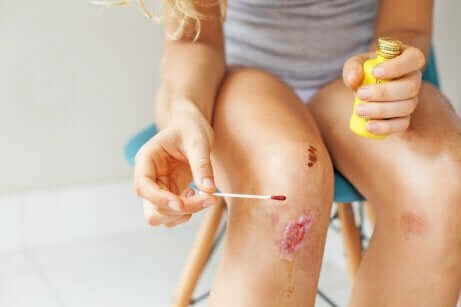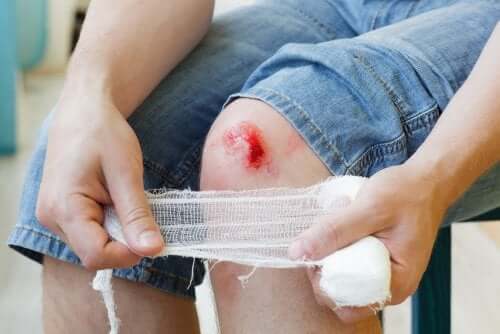6 Steps To Treat an Infected Wound


Written and verified by the nutritionist Eliana Delgado Villanueva
How many times have you been faced with an injury and not known what to do? In this article, we’ll tell you everything you need to know to treat an infected wound or other types of wounds.
Distraction, haste, and tiredness are often the cause of small accidents inside and outside the home. It’s very common that when you get an injury the wound becomes infected. If you don’t treat it, it can have negative health consequences. It’s important to treat these infected wounds as soon as possible.
What are the risk factors for infection?

A wound is more likely to become infected if it:
- Isn’t cleaned or treated it within the next 8 hours.
- Is the result of a piercing, for example with a nail or broken glass.
- Contains dirt or saliva.
- Comes from a bite from a human or an animal.
- Takes a long time to heal.
- Occurs in a person who has diabetes, alcoholism, or a compromised immune system.
You might be interested in reading: How to Treat a Superficial Burn
How do you know if the wound is infected?
If you’re not sure if you have an infected wound, you should check for these signs:
- Local or general fever, accompanied by continuous redness of the area, swelling at the edges, and tenderness.
- Persistent pain, even with gentle movements. In extreme cases, you might have sharp or stinging pain.
- Pus discharge.
- Absence of signs of scarring.
- Bad smell and appearance.
If you notice these signs you can be sure that the area is infected by bacteria, and you should treat it very carefully before it worsens.
Steps to treat an infected wound
Step 1

First, you have to clean the wound with soap and water. It’s normal for it to hurt and itch due to infection. This serves to remove any dirt and blood stuck to it. You should clean the wound with gauze because if you use cotton, it can leave traces of fibers. It’s even worth using a good over-the-counter antiseptic.
Step 2
Ideally, you should cover the open wound with a sterile bandage. To do this, you have to wash your hands very well, to prevent the infection from getting worse. If the area has blisters or pus, it’s best not to remove them to prevent the infection from spreading.
Step 3 to treat an infected wound
You should check the wound frequently to make sure it’s healing properly. Natural products like aloe vera could help heal the wound and clear the infection. This is thanks to the regenerating and healing properties of this plant.
Step 4
If a significant number of days pass and you don’t see any improvement, you should see a doctor, as it could be a more complicated infection and require antibiotic medications that your doctor should prescribe to avoid risks with self-medication.
Step 5
Carefully examine the wound to see if it looks red and if the area is hot and swollen. If it’s hot and swollen in addition to hurting, it’s clearly an infection.
Step 6 to treat an infected wound
Check your body temperature with a thermometer under your armpit. If your temperature is higher than normal, it could indicate a severe infection, so we advise you to visit the doctor right away.
How to prevent infection in wounds

Ideally, when you have a wound you should take action right away so that it doesn’t become infected. It’s best to clean the area well with saline to eliminate bacteria. Then you should cover the wound with gauze and apply antiseptic daily. That way in a few days, the skin will heal.
Read also: How to Make a Travel First Aid Kit
How are infections treated?
Treatment will probably depend on the type of infection and its severity. Your doctor may prescribe oral antibiotics to fight bacteria. You can also rinse the wound with an antibiotic solution or apply an antibiotic ointment. If a buildup of pus (abscess) forms, a doctor will open it to let the fluid out. If the infection is very serious, you may need hospital care.
Now that you know how to heal an infected wound, it’s time for you to put it into practice when the time comes. However, remember: when in doubt, get help from a doctor.
All cited sources were thoroughly reviewed by our team to ensure their quality, reliability, currency, and validity. The bibliography of this article was considered reliable and of academic or scientific accuracy.
- Ledermann D, Walter. (2009). Darwin y las bacterias. Revista chilena de infectología, 26(1), 60-65. https://dx.doi.org/10.4067/S0716-10182009000100010
- Da Silva, Priscilla Nicácio, de Almeida, Onislene Alves Evangelista, & Rocha, Izabella Chrystina. (2014). Terapia tópica en el tratamiento de las heridas crónicas. Enfermería Global, 13(33), 33-45.
- Rodríguez Domínguez Ileana, Santana Gutiérrez Odalis, Recio López Orlando, Fuentes Naranjo Marilín. Beneficios del Aloe Vera l. (sábila) en las afecciones de la piel. Rev Cubana Enfermer [Internet]. 2006 Sep 22( 3 ). Disponible en: http://scielo.sld.cu/scielo.php?script=sci_arttext&pid=S0864-03192006000300004&lng=es.
This text is provided for informational purposes only and does not replace consultation with a professional. If in doubt, consult your specialist.








